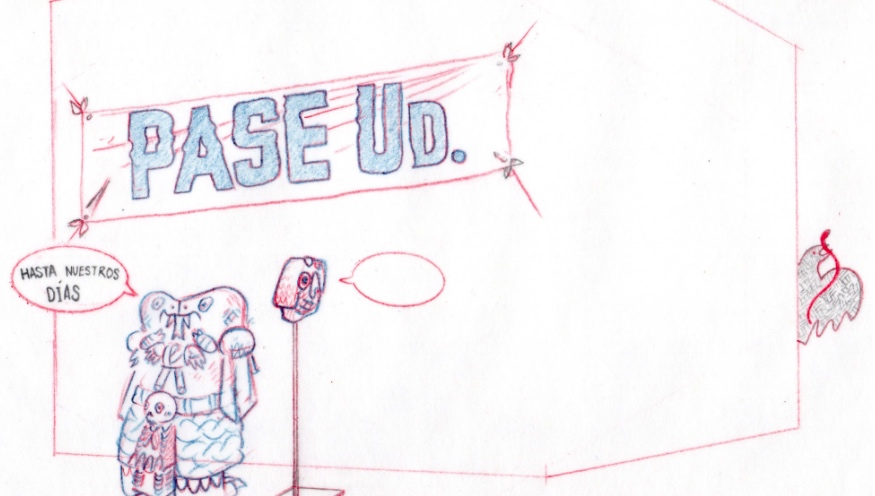
Josué Mejía
Pase Ud. Hasta nuestros días
Exhibition
-> Feb 7 2023 – Apr 1 2023
Proyectos Monclova presents the exhibition Pase Ud. Hasta nuestros días by the artist Josué Mejía.
History as Cartoon
One of Marx’s most famous lines reads: “all facts and personages of great importance in world history occur, as it were, twice... the first time as tragedy, the second as farce.” Thus begins The 18th Brumaire, his book about the coup d’état led by the French president-turned-emperor, Louis-Napoléon Bonaparte, in 1851. Marx regards certain historical events as failed and indeed laughable attempts to emulate a predecessor; in other words, a good synonym for comedy. And among the visual arts, the likeliest parallel to comedy would undoubtedly be the cartoon. So, paraphrasing Marx, we could say that history repeats itself as cartoon.
This is a handy way of understanding the artistic discourse of Josué Mejía (Mexico City, 1994). His use of cartoons, which he has mastered thanks to his prodigious talent as an illustrator, goes hand in hand with his very clever way of filling his pointed critiques with irony, in projects that review events from Mexican history: the country’s industrialization after World War II, or the relationship between modern art in Mexico and the United States, such as in the celebrated exhibition Twenty Centuries of Mexican Art, held at New York’s Museum of Modern Art (MoMA) in 1940.
Indeed, this paradigmatic example of the history of international exhibitions of Mexican art constitutes the theme of Mejía’s current show, which he has titled Pase Ud. hasta nuestros días (Come Right into Our Time). Dripping with sarcasm, the title makes fun of the persistence of these kinds of shows, which have been organized from the mid-twentieth century to the present, with their rigid, unchanging way of categorizing Mexican art (and which the MoMA exhibition in a way helped to validate).
It is important to note that the artist does not seek to “remake” the MoMA exhibition through a strategy of reproducing archival materials, the show’s history, or its exhibition design (which historical curatorial studies have defined in terms of “period rooms”). Instead, Mejía’s cartoons on fresco comment on his clever title for his first show at Proyectos Monclova implies: namely, that a curatorial structure conceived eighty years ago for an exhibition in New York— with its division into pre-Hispanic, colonial, popular, and modern periods—has persisted into our own time as the canonical way of periodizing art history and art institutions in Mexico.
Nevertheless, Josué Mejía’s pieces are not limited to elaborating a conceptual critique of past events. His work also encompasses the pictorial materiality of the fresco, the visual and figurative richness of the cartoon strip, museum objects, and installation as a broad field of revisited visual and aesthetic reflections. It is about the validity of the preferred artistic techniques of art in Mexico (such as fresco), and about the possibility of introducing fiction into the solemn discourse of history, smuggling it into the hidden details of historiographical research in the form of institutional critique.
It is notable how, through drawing, Mejía adds more imagination and levity to solemn moments of the past, which we tend to read from the rigid and severe standpoint of History with a capital H. Certainly, the artist chooses events that invite him to invent a substantial imaginary for himself. The exhibition Twenty Centuries of Mexican Art is the perfect catalyst for taking a poetic approach to its contents, works and objects, its record, and exhibition design. But it is just as important for the artist to reflect what was exhibited there, including the means of installing the work that were used at the MoMA. He breathes new, animate life into the former through drawing (hence another name for cartoons: animations), which in Mejía’s case entails an aesthetic linked to modernity, as if these cartoons were also part of the past, thanks to his peculiar style of drawing, whose genealogy we can trace back to the characteristic lines of newspaper comic strips, Walt Disney films, or the comic strips of twentieth-century modern Mexican illustrators. His reading of the means of installation used in Twenty Centuries functions as the contemporary counterpart of Pase Ud. hasta nuestros días. Josué Mejía resurrects a museal fantasy consisting of artworks, plinths, frames, colorful walls, and decorative elements, in order to accentuate the presence of fiction in history, with a certain degree of exhibition- design-related humor, very common in his installations.
Finally, it is important to recall that the anachronism of Josué Mejía’s cartoons is heightened by his use of another, equally anachronistic device: namely, fresco, a technique that, undoubtedly and thanks to the life everlasting of Mexican muralism, claimed a leading role in the history of art in the twentieth century. Onto this technical anachronism are spilled the synchronic critiques dreamt up by Josué Mejía: again he points a reflexive gaze at historical events and brings a sense of comedy or parody to them, recalling the paraphrase of Marx with which I began this introduction. Or, as the Mexican novelist Fernando de Paso once said, “history doesn’t repeat itself, but it does sometimes parody itself.”
— Carlos E. Palacios